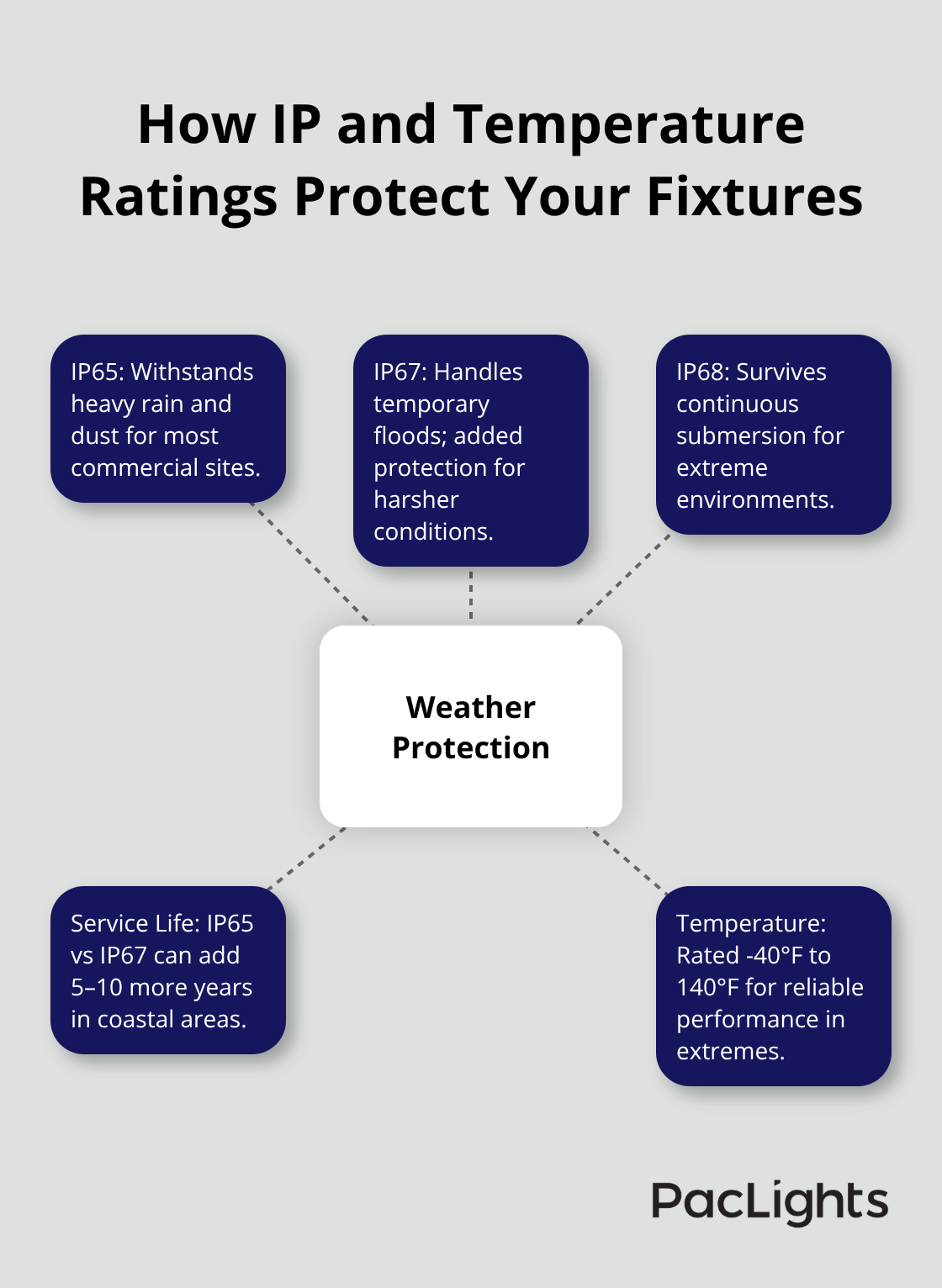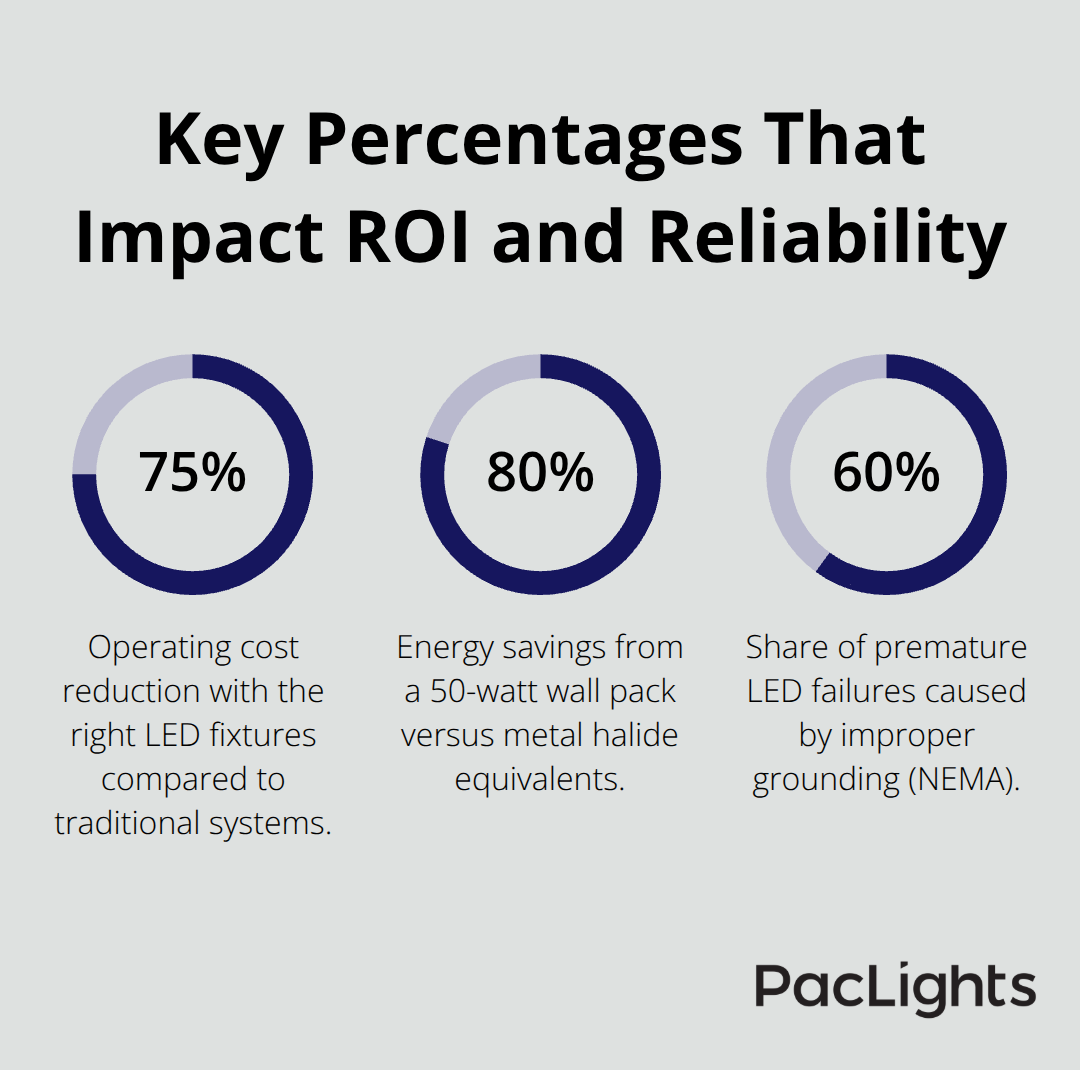Commercial buildings need proper lighting that balances performance, durability, and cost efficiency. Poor lighting choices lead to higher energy bills and frequent replacements.
We at PacLights help property managers select exterior LED lights for commercial buildings that meet specific requirements. The right fixtures reduce operating costs by up to 75% compared to traditional lighting systems.
What Specifications Matter Most for Commercial Exterior LEDs
Light Output Requirements for Different Applications
Light output requirements vary based on your specific application and local building codes. Parking lots need 5-10 foot-candles of illumination according to Illuminating Engineering Society guidelines, while building entrances require 15-25 foot-candles for safety compliance. A single 150-watt LED area light produces approximately 20,000 lumens and covers roughly 2,500 square feet at recommended levels. Property managers often overlight spaces, which wastes energy and money on unnecessary illumination.

Weather Protection Standards That Determine Longevity
IP ratings determine fixture longevity in harsh conditions. IP65-rated fixtures withstand heavy rain and dust, which makes them suitable for most commercial applications. IP67 ratings handle temporary floods, while IP68 fixtures survive continuous submersion.

The difference between IP65 and IP67 can mean 5-10 years of additional service life in coastal environments. Temperature ratings matter equally – fixtures rated for -40°F to 140°F perform reliably in extreme climates without premature failure.
Energy Efficiency Metrics That Drive Real Savings
LED fixtures with 120+ lumens per watt efficacy deliver maximum energy savings. A 400-watt metal halide fixture costs $300+ annually to operate, while a comparable 150-watt LED costs $75 per year (according to Department of Energy calculations). This $225 annual savings per fixture creates 18-24 month payback periods. DLC-qualified fixtures qualify for utility rebates that reduce upfront costs by 30-50%. Smart controls add another 20-30% energy reduction through occupancy sensors and daylight harvesting, though they require proper setup to avoid efficiency losses from unnecessary activation.
These technical specifications form the foundation for fixture selection, but the type of fixture you choose depends on your specific commercial application and installation location.
Which Fixture Type Works Best for Your Commercial Space
Area Lights for Comprehensive Parking Lot Coverage
Area lights provide the most effective solution for parking lot applications because they distribute light evenly across large spaces. A 150-watt LED shoebox fixture covers 2,500 square feet at 5-10 foot-candles, which meets Illuminating Engineering Society standards for most commercial parking areas. Property managers should mount these fixtures 20-30 feet high on poles for optimal spacing ratios. The uniform light distribution eliminates dark spots that create security concerns and liability issues.
Wall Pack Lights for Targeted Building Perimeter Illumination
Wall pack lights excel at building perimeters and walkways where you need directional light rather than broad coverage. A 50-watt wall pack provides adequate illumination for a 40-foot building section while it consumes 80% less energy than traditional metal halide equivalents. Full cutoff wall packs prevent light trespass onto neighboring properties and reduce glare complaints from adjacent businesses or residents.
Flood Lights for Security and Architectural Applications
Flood lights serve dual purposes for security and architectural accent applications. Security installations require 30-50 foot-candles of illumination according to Department of Energy guidelines, which means you need 100-200 watt LED floods for most commercial entrances. These fixtures produce 15,000-30,000 lumens and mount 15-25 feet high for effective coverage without harsh shadows.
Accent applications use lower wattage floods (20-75 watts) to highlight building features or landscaping elements. Smart controls work particularly well with flood lights because occupancy sensors can trigger full brightness when motion occurs while they maintain lower ambient levels during off-peak hours. This approach reduces energy consumption by 40-60% compared to constant full-power operation.
The success of any exterior lighting project depends heavily on proper installation techniques and the integration of advanced control systems that maximize both performance and efficiency.
What Installation and Maintenance Factors Affect Long-Term Performance
Professional Installation Requirements
Professional installation determines whether fixtures last 15 years or fail within 5 years. Electrical connections need weatherproof junction boxes rated IP67 or higher, and improper grounding causes 60% of premature LED failures (National Electrical Manufacturers Association data). Licensed electricians must handle high-voltage installations above 120 volts, and most commercial exterior fixtures operate at 277-480 volts. Pole-mounted area lights need concrete foundations that extend 4-6 feet deep based on wind load calculations, while wall-mounted fixtures require structural analysis for buildings with metal siding or masonry walls.
Maintenance Schedules That Maximize LED Lifespan
Commercial LED fixtures need quarterly cleaning with microfiber cloths to maintain optimal light output, as dirt accumulation reduces illumination by 20-30% annually. Annual inspections should check gasket seals, lens clarity, and electrical connections because moisture intrusion destroys LED drivers within months. Replace photocells every 3-4 years and occupancy sensors every 5-7 years, as these components fail before the LEDs themselves. Most quality LED fixtures operate 80,000-100,000 hours, which translates to 15-20 years of typical commercial use, but poor maintenance cuts this lifespan in half.
Smart Controls That Deliver Additional Energy Savings
DALI and 0-10V dimming systems provide the most reliable control options for commercial installations, while wireless systems create maintenance headaches through connectivity issues. Occupancy sensors reduce energy consumption by 30-40% when properly commissioned, but they need precise sensitivity adjustments to avoid false triggers from vehicle movement or wind. Daylight harvesting saves an additional 15-25% when it dims fixtures as natural light levels exceed set points. Smart controls require annual recalibration and firmware updates to maintain peak performance, and backup manual overrides prevent complete system failures when control malfunctions occur.

Final Thoughts
Property managers need exterior LED lights for commercial buildings that deliver reliable performance and cost savings. Fixtures with 120+ lumens per watt efficacy and IP65+ weather protection provide the best return on investment. Area lights handle parking lots effectively, wall packs illuminate building perimeters, and flood lights offer security coverage where needed.
Quality LED fixtures cut energy costs by 75% compared to traditional systems and operate for 15-20 years with proper care. Professional installation and smart controls maximize these benefits through dependable operation and energy reductions of 30-40%. The initial investment pays back within 18-24 months through lower utility bills and reduced maintenance expenses (DLC-qualified products also qualify for utility rebates that reduce upfront costs by 30-50%).
We at PacLights offer comprehensive solutions including area lights, wall packs, and flood lights with optional daylight and motion controls. Our team provides lighting layout designs and ROI assessments to help property managers optimize both performance and cost savings. Contact us to discuss your specific commercial exterior lighting requirements.


Disclaimer: PacLights is not responsible for any actions taken based on the suggestions and information provided in this article, and readers should consult local building and electrical codes for proper guidance.